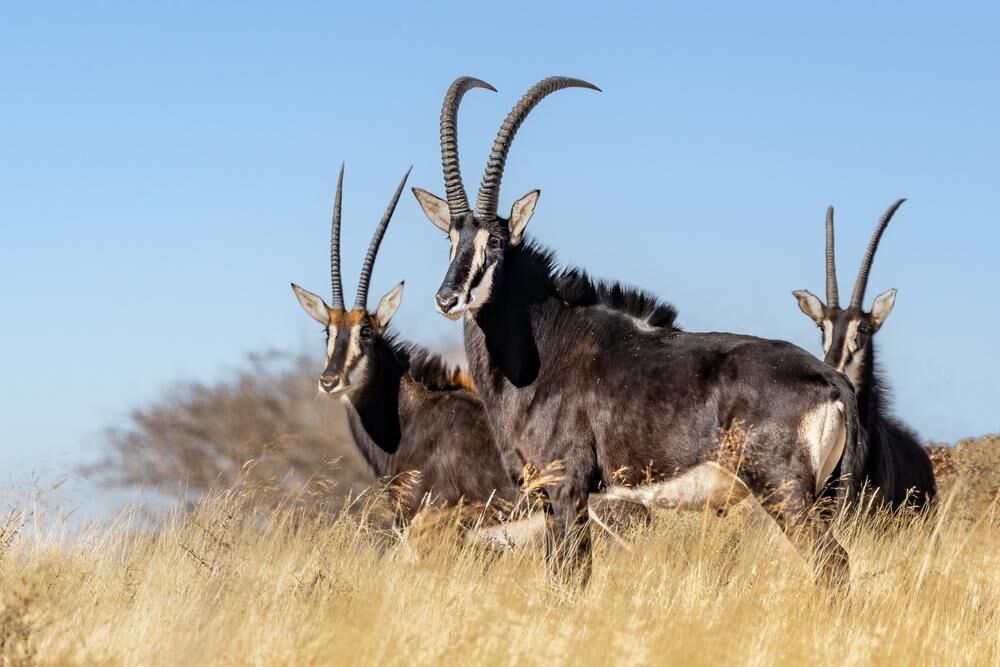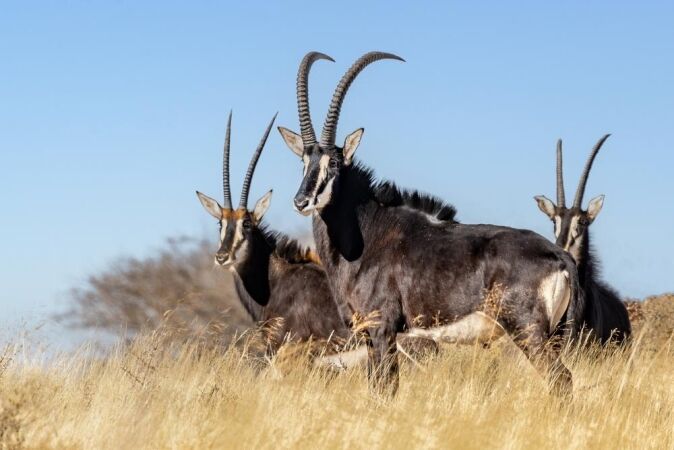

The Sable Antelope (Hippotragus Niger) or “mbarapi” in Swahili, is considered to be the original species of the Hippotragus tree which also includes the bontebok, roan antelope, and blesbok. These antelopes are a true sight to behold and should be on your list when on an African big game hunting safari.
For hunters interested in big game hunting in Africa, these sable antelopes are found in savannah woodland and grassland areas in Southern Kenya, Eastern Tanzania, Mozambique, and Southern Africa, with an entirely separate population in Angola.
Herds usually involve females, calves, and one dominant bull. Young males are chased off at around three years but all females and other young remain. If the herd become too large, they will separate into new herds, each with their own dominant bull. Young males will form bachelor groups and will fight amongst themselves for dominance, with the “winner” joining a separated herd of female and juvenile animals.
The breeding season of the sable antelope depends on the climate, with births taking place in the rainy season when food and coverage are more available. Females gestate for 9 months and birth a single calf that at birth is sandy-colored. The calf will remain hidden from the herd until 10 days old. Calves are weaned at around 8 months and both sexes reach sexual maturity around 2–3 years. As they grow, the calves coat darkens and they will gain their status as a member of the herd.
Sables consume mainly leaves of mid-length grasses and herbs, but when necessary will chew bones to boost mineral intake. They also enjoy consuming vegetation growing from termite mounds. They are active during daylight hours and rest at night, and this can be influenced by factors like temperature, food availability, predator activity, and the season. Water is essential to the sable and they will travel every 2–4 days to a water source, this helps them avoid predators that could be watching general game herds during grazing and drinking.
Predators of the sable, as with many African big game, include lions, leopards, hyenas, wild dogs, and Nile crocodiles. Adult sables will fight aggressively, using their horns as a means to impale their attacker and even cause death. Contrary to this, sables are generally considered the most calm, confident and even graceful of their antelope family.
Name:
Hippotragus Niger
Weight:
520 pounds
Shoulder Height:
4.9 – 5+ feet
Range:
Southern Kenya, Eastern Tanzania, Mozambique, Southern Africa and Angola
Mating Season:
Birthing Time in the Rainy Season
Life span:
17 years
The Sable Remains a Popular Plains Game Hunting Trophy
When on the game hunting safari, look for antelope that are compact and robust in build, often considered to be barrel-like with a thick neck. The sable antelope males are larger measuring 4.9 feet at the shoulder and weighing round 520 pounds. Females typically stand around 4.3 feet at the shoulder and weigh in the region of 490 pounds. Their tails measure around 16–30 inches and feature a tuft at the end. In general, a sable antelope’s coat color ranges from a rich chestnut brown to black. Females and young are typically chestnut to dark brown, while males continue darkening and turn black around three years of age. Young calves of less than two months of age are usually a light tan color and regardless of age, the underbelly, cheeks, and chin are white. Both sexes grow ringed horns that arch backwards, with a male sable’s measuring 32–65 inches and those of a female growing to be 24–40 inches in length.
Sables can be targeted year-round for big game hunting in Africa, with the preferred time being April – May and late June – October. This helps to avoid intense summer heat and ensures the bush isn’t as dense to cover your target. When on a game hunting safari targeting sable, the classic method of stop and stalk is considered the best approach. Depending on terrain one might need to take a shot from between 100–180 yards. A face-to-face shot should typically hit the chest center where the throat and body meet, broadside shot should aim at the shoulder or just behind.
Given their confident, almost cocky nature, and simply beautiful coat, the sable is a gem of a trophy to target when big game hunting in Africa. And it’s without a doubt that a set of those horns would be a great reminder of your time on hunting game in Africa.
When hunting sable, do not choose anything less than a .270 caliber. Thirty calibers like a 30.06, or a well-placed shot from a .308 provide more than enough kinetic energy to bring down this antelope. Bigger calibers loaded with solids, such as a .338 or .375 work extremely well. If the shots are going to be further in distance, a 7mm or 300-win mag should be considered.
Search from our range of Hunts across various popular destinations in Africa.
Find A Hunt